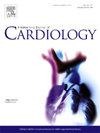急性肺栓塞导管治疗的临床特征和结果的性别差异。
IF 3.2
2区 医学
Q2 CARDIAC & CARDIOVASCULAR SYSTEMS
引用次数: 0
摘要
背景:急性肺栓塞(PE)是一种发病率越来越高的心血管急症。导管定向治疗(CDTs)越来越多地用于高风险或中高风险PE患者,当手术栓塞切除或全身溶栓(ST)禁忌或无效时。尽管先前的研究表明PE女性预后较差,但CDTs结果的性别差异尚不清楚。目的:探讨性别对急性PE患者行CDTs的临床特征、手术并发症和临床结局的影响。方法:这项回顾性多中心研究纳入了意大利5个中心连续接受CDTs治疗的高危和中高危PE患者。收集并分析临床资料、手术并发症及结果。出血事件按照出血学术研究联盟(BARC)的标准进行分类。结果:纳入191例患者(女性101例,53. %;90名男性,47 %)主要接受超声辅助溶栓治疗(USAT, 69 %),设备分配无性别差异。与男性相比,女性更频繁地经历了心脏骤停(11 %与3 % p = 0.04),有更少的绝对禁忌症圣(23 %和42 % p = 0.004),和更低的利率最近的大手术(9 % 22节 % p = 0.01)。女性经验的住院死亡率显著升高(20 %与9 %,或2.53,95 %可信区间1.09 - -6.41,p = 0.037),更高的出血率(22 %与10 %,或2.53,95 %可信区间1.13 - -6.13,p = 0.029),和更高的1年死亡率(29.1 % 12.7 vs %,aHR 2.37, 95 %可信区间1.12 - -5.04,p = 0.024)。结论:接受CDTs治疗PE的女性表现出更大的临床严重程度,经历更多的手术并发症,早期和中期预后更差,强调了对接受CDTs治疗PE的患者采取针对性别的管理策略的必要性。摘要:对于有禁忌症或对标准治疗反应不足的急性肺栓塞(PE)患者,导管定向治疗(CDTs)是新兴的治疗选择。在这项多中心研究中,我们分析了接受CDTs治疗的高、中高风险PE患者的临床表现和结局的性别差异。在191例入组患者中,53% %为女性。大多数患者表现为中高风险PE,并接受超声辅助溶栓(USAT)治疗。与男性相比,女性表现出更严重的临床症状,手术并发症发生率更高,出血和住院死亡率明显更高。女性性别是1年全因死亡率的独立预测因子。这些发现强调了性别特异性管理策略对接受CTDs治疗急性PE患者的重要性。本文章由计算机程序翻译,如有差异,请以英文原文为准。

Sex-specific disparities in clinical characteristics and outcomes of catheter-directed treatments for acute pulmonary embolism
Background
Acute pulmonary embolism (PE) represents a cardiovascular emergency with increasing incidence. Catheter-directed treatments (CDTs) are increasingly used for high-risk or intermediate-high-risk PE patients when surgical embolectomy or systemic thrombolysis (ST) is contraindicated or ineffective. Although prior research suggests poorer outcomes in women with PE, sex-specific differences in CDTs outcomes remain unclear.
Aims
To investigate the influence of sex on clinical characteristics, procedural complications, and clinical outcomes among patients undergoing CDTs for acute PE.
Methods
This retrospective multicenter study included consecutive high-risk and intermediate-high-risk PE patients treated with CDTs across five Italian Centers. Clinical data, procedural complications and outcomes were collected and analyzed. Bleeding events were classified according to Bleeding Academic Research Consortium (BARC) criteria.
Results
We included 191 patients (101 women, 53 %; 90 men, 47 %) treated primarily with ultrasound-assisted thrombolysis (USAT, 69 %), with no sex-based differences in device allocation. Compared with men, women more frequently experienced cardiac arrest (11 % vs. 3 %, p = 0.04), had fewer absolute contraindications to ST (23 % vs. 42 %, p = 0.004), and lower rates of recent major surgery (9 % vs. 22 %, p = 0.01). Women experienced significantly higher in-hospital mortality (20 % vs. 9 %, OR 2.53, 95 % CI 1.09–6.41, p = 0.037), higher bleeding rates (22 % vs. 10 %, OR 2.53, 95 % CI 1.13–6.13, p = 0.029), and higher 1-year all-cause mortality (29.1 % vs. 12.7 %, aHR 2.37, 95 % CI 1.12–5.04, p = 0.024).
Conclusions
Women undergoing CDTs for PE present with greater clinical severity, experienced more procedural complications, and had worse early and mid-term outcomes, underscoring the need for sex-specific management strategies in patients undergoing CDTs for PE.
Condensed abstract
Catheter-Directed Treatments (CDTs) are emerging therapeutic options for acute pulmonary embolism (PE) patients with contraindications or inadequate response to standard therapies. In this multicenter study, we analyzed sex-specific differences in clinical presentation and outcomes of patients with high and intermediate-high risk PE treated with CDTs. Among 191 patients enrolled, 53 % were women. Most patients presented with intermediate-high risk PE and were treated with ultrasound-assisted thrombolysis (USAT). Women presented with more severe clinical profiles, had higher procedural complication rates, and experienced significantly greater bleeding and in-hospital mortality compared with men. Female sex was an independent predictor of 1-year all-cause mortality. These findings highlight the importance of sex-specific management strategies for patients undergoing CTDs for acute PE.
求助全文
通过发布文献求助,成功后即可免费获取论文全文。
去求助
来源期刊

International journal of cardiology
医学-心血管系统
CiteScore
6.80
自引率
5.70%
发文量
758
审稿时长
44 days
期刊介绍:
The International Journal of Cardiology is devoted to cardiology in the broadest sense. Both basic research and clinical papers can be submitted. The journal serves the interest of both practicing clinicians and researchers.
In addition to original papers, we are launching a range of new manuscript types, including Consensus and Position Papers, Systematic Reviews, Meta-analyses, and Short communications. Case reports are no longer acceptable. Controversial techniques, issues on health policy and social medicine are discussed and serve as useful tools for encouraging debate.
 求助内容:
求助内容: 应助结果提醒方式:
应助结果提醒方式:


